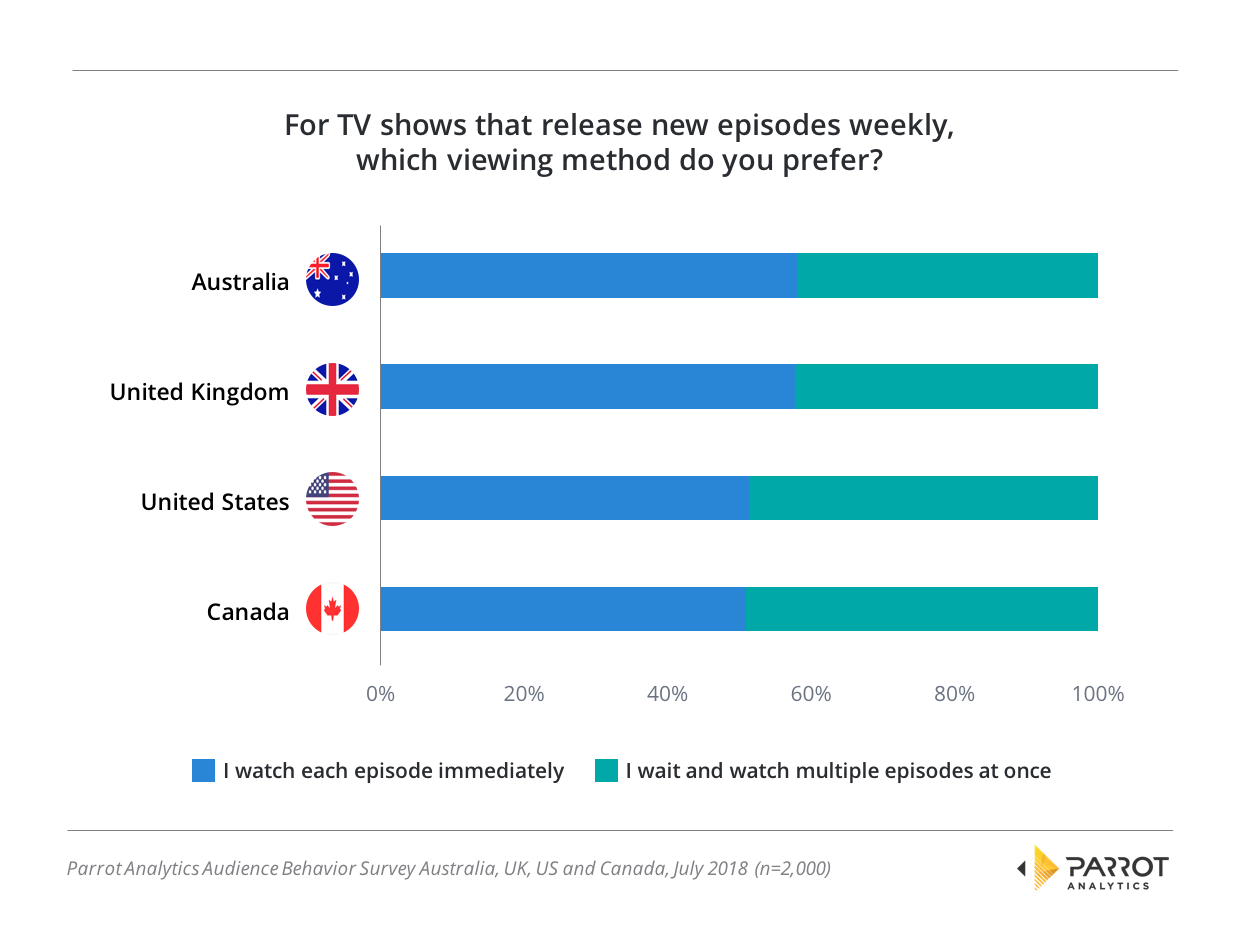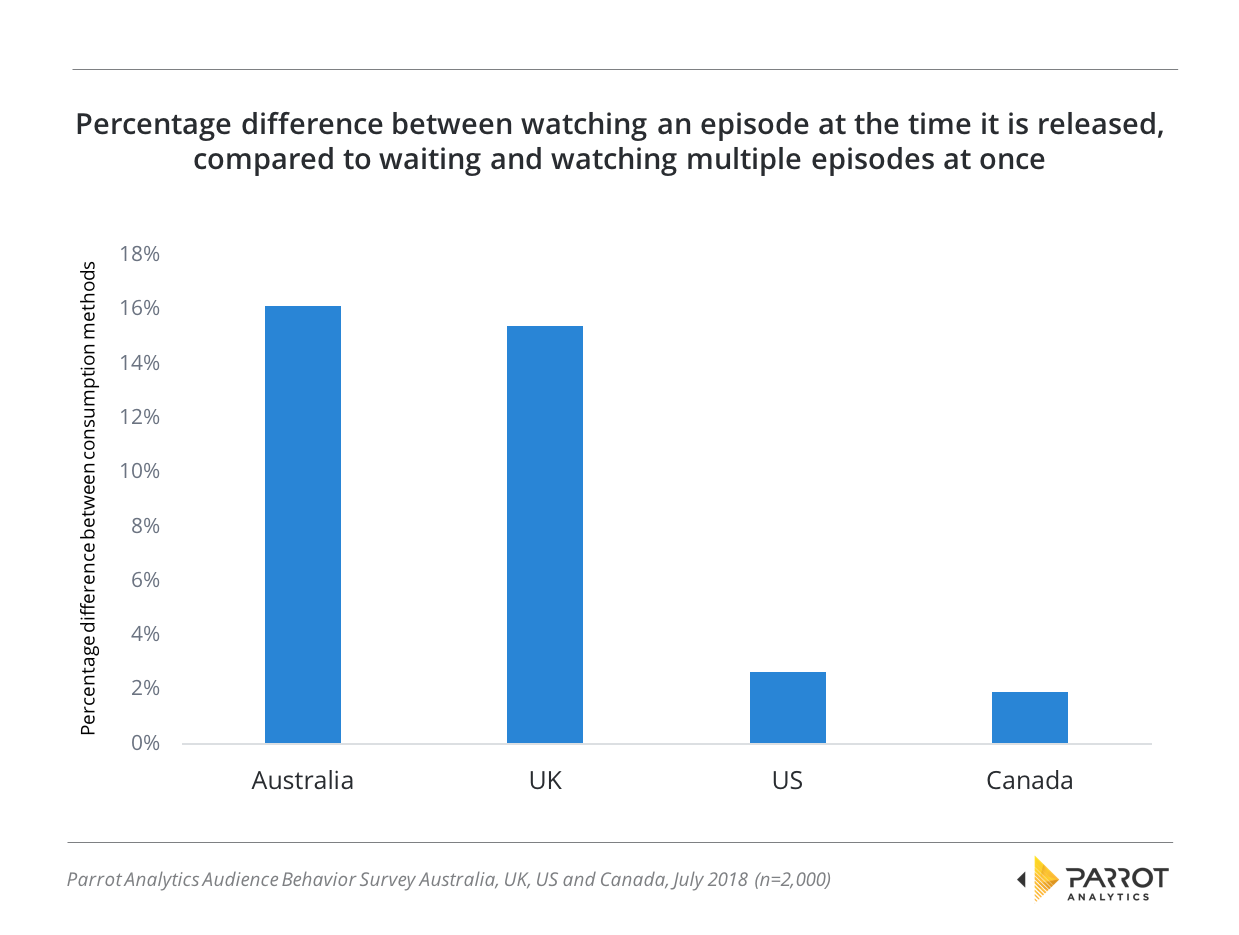Image: Killing Eve, BBC America
The phenomenon of “binge-watching” or “marathoning” TV – watching multiple episodes of a show in a single session – has seen a surge in cultural awareness in the last few years.
Binging is not new behaviour, as it has been possible at least since TV shows first arrived on home physical media, however, it is hard to deny that the convenience of accessing entire seasons on streaming platforms has greatly increased the popularity of binging. Netflix in particular encourages the behavior by releasing all episodes of a new season for most of its shows at once – the only major streaming platform to do so.
In fact, most TV is still episodic, where new episodes of a season are released at regular intervals, typically weekly. Episodic viewing therefore is watching these episodes as soon as they come out.
Although often thought of as a streaming service behaviour, audiences in many markets can binge-watch even without specifically paying for a streaming service. Many broadcast networks offer a catch-up service that allows viewing of previously aired content online, usually for a set period like four weeks after broadcast.
However, there are still advantages to viewers from episodic viewing of content. Spacing out episodes allows fans to engage more, both with the content and each other, giving time to reflect, theorize and discuss each episode without fear of spoilers, as the entire community is at the same place in the season. Once a fan is used to discussing the show with others, the incentive is there to watch new episodes as soon as possible to continue being able to participate.
Reality shows like RuPaul’s Drag Race have mastered this art, making each new episode a “television event” that is enhanced by the live-viewing experience, whether that is co-viewing in person or online.
As both methods have reasons that a viewer might prefer, the question is: When free to choose, do people prefer binge-watching television episodes or watch them episodically?
Which viewing method is preferred?
To discover the answer, Parrot Analytics has commissioned a survey involving participation from 500 people each in America, Canada, Britain and Australia, asking the following question: “For TV shows that release new episodes weekly, which viewing method do you prefer?”
Participants were given two options to answer this question. They could either answer “I watch each episode immediately”, or, “I wait and watch multiple episodes at once”.
The breakdown of these responses has been provided in the chart below:
In all four countries surveyed, the majority preferred to watch episodes immediately and stay up-to-date with the TV show. This demonstrates that the episodic release schedule and the excitement of “event” television is still what most viewers want, although there are almost as many that like the convenience of binge-watching.
Additionally, the size of the majority that preferred episodic viewing is different in each country; presenting the data in terms of the percentage difference between each answer in each country allows for easier comparisons as the following chart shows:
Here we see that Australians are the most likely to want to see each episode as it is released, with 16.1% more Australians preferring episodic consumption over binge consumption. The UK is similar, with 15.4% more of Brits favoring episodic viewing.
On the other hand, Canadians are least likely to wait. Only 1.9% more Canadians said they preferred episodic viewing than binging. This narrow majority was similar to the U.S. result, where only 2.6% were in favor of episodic TV series consumption.
It will be interesting to see how these market preferences develop as SVOD penetration continues to increase. The natural assumption is that viewers will be drawn to the convenience of binge-watching.
However, media companies are fighting back with increasingly innovative ways to replicate the “event viewing” nature perfected by reality competition titles, but the concept also holds true for scripted titles, as demonstrated by the recent example of Killing Eve.
Which industry innovations are successful for encouraging both binge-watching and episodic behaviour is an emerging question and Parrot Analytics will continue to monitor the success of all TV series for either consumption behaviour closely with our global TV demand measurement capabilities.
For more information about trends in audience behavior, reach out to Parrot Analytics for a live demonstration our Demand Portal, or watch our latest product video.



